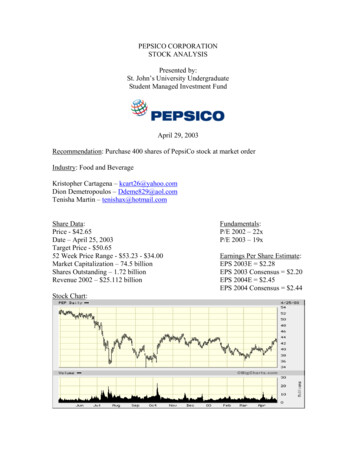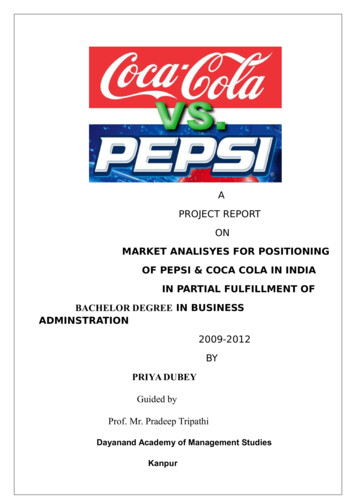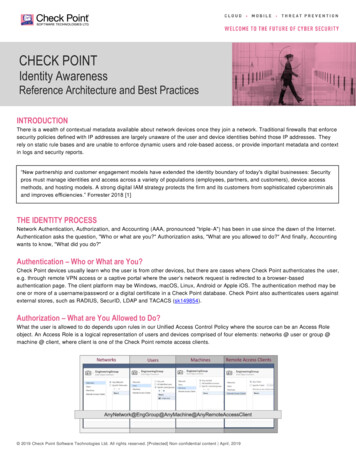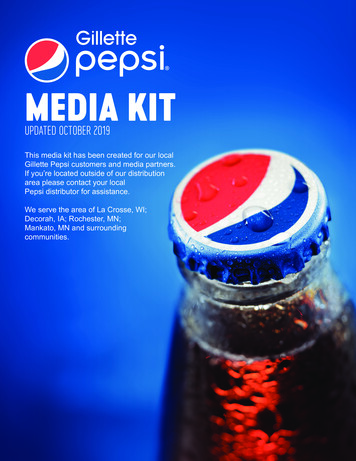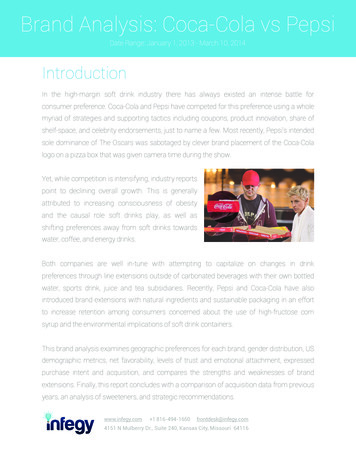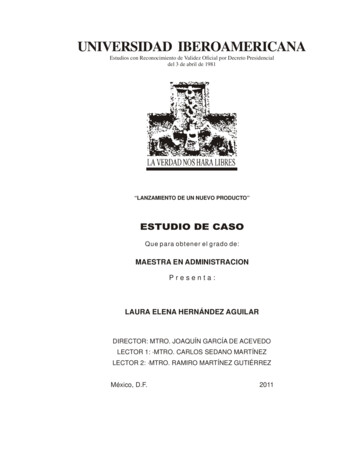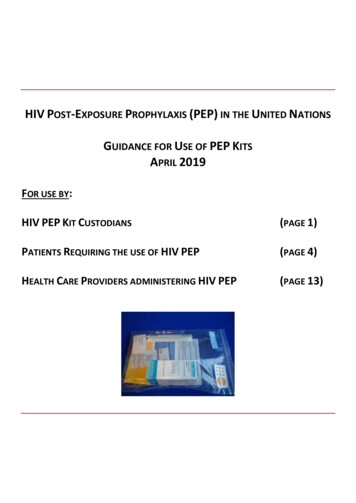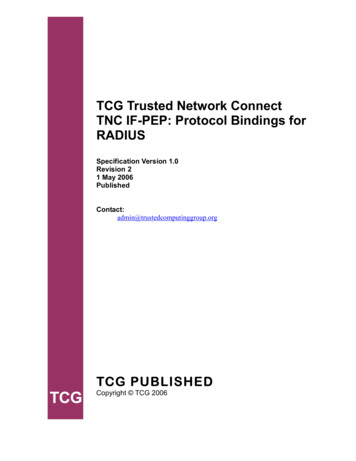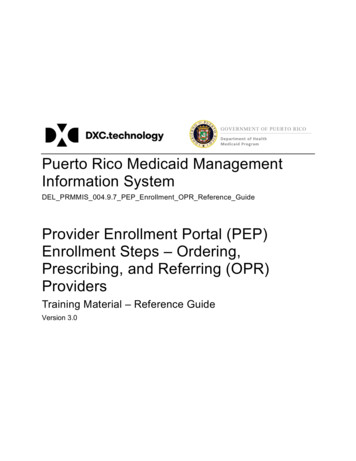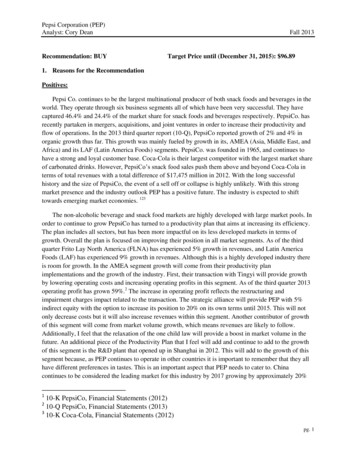
Transcription
Pepsi Corporation (PEP)Analyst: Cory DeanRecommendation: BUYFall 2013Target Price until (December 31, 2015): 96.891. Reasons for the RecommendationPositives:Pepsi Co. continues to be the largest multinational producer of both snack foods and beverages in theworld. They operate through six business segments all of which have been very successful. They havecaptured 46.4% and 24.4% of the market share for snack foods and beverages respectively. PepsiCo. hasrecently partaken in mergers, acquisitions, and joint ventures in order to increase their productivity andflow of operations. In the 2013 third quarter report (10-Q), PepsiCo reported growth of 2% and 4% inorganic growth thus far. This growth was mainly fueled by growth in its, AMEA (Asia, Middle East, andAfrica) and its LAF (Latin America Foods) segments. PepsiCo. was founded in 1965, and continues tohave a strong and loyal customer base. Coca-Cola is their largest competitor with the largest market shareof carbonated drinks. However, PepsiCo’s snack food sales push them above and beyond Coca-Cola interms of total revenues with a total difference of 17,475 million in 2012. With the long successfulhistory and the size of PepsiCo, the event of a sell off or collapse is highly unlikely. With this strongmarket presence and the industry outlook PEP has a positive future. The industry is expected to shifttowards emerging market economies. 123The non-alcoholic beverage and snack food markets are highly developed with large market pools. Inorder to continue to grow PepsiCo has turned to a productivity plan that aims at increasing its efficiency.The plan includes all sectors, but has been more impactful on its less developed markets in terms ofgrowth. Overall the plan is focused on improving their position in all market segments. As of the thirdquarter Frito Lay North America (FLNA) has experienced 5% growth in revenues, and Latin AmericaFoods (LAF) has experienced 9% growth in revenues. Although this is a highly developed industry thereis room for growth. In the AMEA segment growth will come from their productivity planimplementations and the growth of the industry. First, their transaction with Tingyi will provide growthby lowering operating costs and increasing operating profits in this segment. As of the third quarter 2013operating profit has grown 59%.2 The increase in operating profit reflects the restructuring andimpairment charges impact related to the transaction. The strategic alliance will provide PEP with 5%indirect equity with the option to increase its position to 20% on its own terms until 2015. This will notonly decrease costs but it will also increase revenues within this segment. Another contributor of growthof this segment will come from market volume growth, which means revenues are likely to follow.Additionally, I feel that the relaxation of the one child law will provide a boost in market volume in thefuture. An additional piece of the Productivity Plan that I feel will add and continue to add to the growthof this segment is the R&D plant that opened up in Shanghai in 2012. This will add to the growth of thissegment because, as PEP continues to operate in other countries it is important to remember that they allhave different preferences in tastes. This is an important aspect that PEP needs to cater to. Chinacontinues to be considered the leading market for this industry by 2017 growing by approximately 20%110-K PepsiCo, Financial Statements (2012)10-Q PepsiCo, Financial Statements (2013)310-K Coca-Cola, Financial Statements (2012)2pg. 1
Pepsi Corporation (PEP)Analyst: Cory DeanFall 2013within the four year time period.4 Although the rate of growth is expected to decelerate for the Soft Drinkindustry it is forecasted to see a large overall growth in the coming years (10% CAGR). With this said, Itook the expected market growth rate and included the additional growth provided by the productivityplan that they have put in place. The snack food industry in China is expected to have the samedecelerating trend in terms of market value growth rate, however, the overall growth rate for the next fouryears is similar to that of the beverage industry. Their productivity plan is still taking effect, which meansthat they should continue to see growth due to their implementations. As the emerging market of Chinadevelops, PepsiCo has positioned itself to capture the revenues of this market. Implementing a plan earlyon provides Pepsi with the opportunity to capture the max revenues the market has to offer. This isbecause majority of the restructuring and impairment charges related to this transaction will already havebeen paid. As PepsiCo continues to reduce the restructuring and impairment charges related to recenttransactions, such as Tingyi, revenues should increase at the same time providing positive revenuegrowth. Pepsi has decreased these charges across all of its segments with large portions of the remainingcharges to be paid by the end of 2013. 5Another Segment of PepsiCo expected to provide growth is the Latin American Foods Segment.Looking at the LAF segment of PEP, the forecasted growth is based upon the growth of PEP’s snack foodrevenues. This is mainly based upon the growth rate of the Brazilian market value. For the past fiveyears it has been growing at about 6% CAGR. The market expects it to grow by about 31.8% over thenext five years with a 5% CAGR.6 These numbers are also similar for the soft drink industry in Brazil.However, PEP is not one of the market share leaders for the soft drink industry. They are a market shareleader in the snack food department, which is why I used this as an indicator for growth within thisgeographic segment. Mexico is another market that will provide growth for PEP. The Snack foodIndustry will be the fuel for growth in this segment. PEP has 39.9% market share of the snack foodindustry in Mexico.7 The Industry has a forecasted growth rate of 6% CAGR. The soft drink industry inMexico is forecasted to see similar results in terms of growth.In addition to continued growth within both industries PEP operates in, dividends play also large rolein this buy recommendation. PEP has seen constant dividend growth over the past ten years and hasconsistently paid dividends on a quarterly basis. Though there has been one quarter where the dividendhas decreased compared to the previous dividend. This occurred in 2012 during the implementation ofits productivity plan. PEP has also increased the percentage of EPS returned to share holders by anaverage of 46.65% over the past seven years. With the cost savings provided by their productivity planand the growth of the industry as a whole, they should have enough free cash flow to execute the full 3billion in approved shareholder returns. As of 11/24/2013 the dividend yield for PEP is 2.27%.8 Along4“Soft Drinks in China” Market Line http://ehis.ebscohost.com10-Q PepsiCo, Financial Statements (2013)6Savory Snacks in Brazil” Market Line http://ehis.ebscohost.com7“Savory Snacks in Mexico” Market Line http://ehis.ebscohost.com8YahooFinance.com5pg. 2
Pepsi Corporation (PEP)Analyst: Cory DeanFall 2013with the dividends PEP has been repurchasing shares of stock. With the combination of these twofactors, shareholders should see increased returns and stock prices.Negatives:As consumer preferences continue to change, PepsiCo needs to continue finding ways to meettheir ever-changing needs. The future sales of carbonated beverages are uncertain across the entireindustry. This uncertainty is reflected by the recent decline in sales volume of carbonated beverages.Consumers have become more concerned with what they put in their body and this has been reflected inthe sales of PepsiCo’s carbonated beverages. In the U.S Carbonated drink sales decreased 1% in 2011,and by 1.5% in 2012. This is something to be concerned with because the U.S. accounts for it’s largestportion revenue (51%, in 2012). PepsiCo experienced a decrease in market share in the use by .4percentage points while Coca-Cola and Dr. Pepper saw increases of .1 percentage point.9The amount of leveraged debt in which PepsiCo has incurred over the past few years is anotheraspect to be concerned with. Although PepsiCo is entering into strategic alliances to better position itselffor the future, it has done so with a cost. In 2007 it had a D/E ratio of 1.004 and in 2012 it had a ratio of2.33. These ratios take into account Total Liabilities/Total Common Shareholders Equity. The company ismuch more highly leveraged at this point, which is something to be concerned about. Although they havebecome highly leveraged they will have enough cash flow to pay off these debts in the future.102. Company AnalysisPepsiCo has long standing success within the industry in which it operates. Its six segments offer alarge verity of products to its consumers. The six segments include Frito Lay North America (FLNA),Quaker Foods North America (QFNA), Latin America Foods (LAF), PepsiCo Americas Beverages(PAB), Europe, and Asia Middle East and Africa (AMEA). Three of the segments are grouped togetherand account for one of the four major segments. FLNA, QFNA, and LAF are responsible for thedistribution and sales of the food products sold in the Americas. Together they accounted for 37% of netrevenue for 2012. Individually they accounted for 21%, 4%, and 12% respectively. PAB is the secondmajor segment, which accounted for 33% of net revenues for 2012. AMEA is the third major segment,and accounted for 10% of net revenues in 2012. The fourth major segment is Europe, which accounted for20% of PepsiCo’s net revenue in 2012. Thus far in 2013, they have accounted for approximately the sameamount in terms of net revenue. According to industry reports growth has slowed over the past few yearsand may be expected to slow to about 2% over the next few years until about 2015. 11Strengths:PepsiCo. has four major strengths that make it a strong competitor within its industry. First is thesize of the company. Coupled with its size, its the strong brand equity and loyal customers provides for astrong company base. They are a household name in most households, particularly in the U.S. The second9Report Linker “Beverage Industry: Market Research Reports, Statistics and Analysis”PepsiCo, Inc. SWOT Analysis, Market Line Reports1110-Q PepsiCo, Financial Statements (2013)10pg. 3
Pepsi Corporation (PEP)Analyst: Cory DeanFall 2013strength of PepsiCo, is its diversification. The six major countries in which it operates include, the U.S.,Russia, Mexico, Canada, U.K., and Brazil. More currently, they have begun operations in China throughits strategic alliance with Tingyi. In terms of revenue, these countries account for, 51%, 7%, 6%, 5%, 3%,and 3% respectively, which allows them to diversify their target markets. By diversifying themselves, theoverall market risk is reduced. The third strength of PepsiCo, is that it continues to experience growth inrevenues and operating income, which are at the lease equivalent to its main competitor. This growthinsures that the company stays competitive. As in any industry this growth is crucial. Lastly, its increasingpresence in emerging markets as paid off for PepsiCo. As demand in developed markets for noncarbonated beverages decreases, developing markets are picking up the slack.Weaknesses:With PepsiCo there is one major weakness to consider. Decreased consumer confidence due tomarket controversies is its major weakness. Bad press or allegations against a food and beverage companyare a regular occurrence. While allegations against its food sector would not hinder the company by alarge margin, but if PAB sector were to take a hit from this it could see a large impact on revenues. This isdue to the fact that PAB accounts for such a large portion of its revenue stream that if there was a largedecrease in sales, the company would take a large hit.Opportunities:Although the industry is highly developed there are opportunities for the company to grow. Thefirst opportunity for PepsiCo to consider is its presence in developing markets with respect to food sales.As the consumption of food increases in these markets PepsiCo can look to tap into these markets andturn the demand for products such as theirs into revenue. This demand provides room for the company togrow. Another opportunity for PepsiCo to consider is the changing preferences and demands of bothdeveloped and developing markets. As people become more health conscious, PepsiCo can develop andproduce products that meet those needs. This provides room for the company to grow within segmentsthat provide a smaller percentage of revenues such as QFNA. By growing segments such as thesePepsiCo can reduce the risk that they are exposed to within the larger segments. The third majoropportunity for PepsiCo to consider is the localization of raw materials used along with other materialsinvolved with the production process. This can decrease the costs of the company along with making iteasier to produce their products due to regulation differences between countries.Threats:As private companies begin to pop up within the industry, PepsiCo needs to be aware of what isout there. This is because, with the recent recession and change in consumer preferences, consumers areturning to alternatives such as private labels and generic brands. In order to stay competitive they need tocontinue staying price competitive along with offering products their consumers are demanding. Risingfood and commodity prices pose an additional risk to the company. This is one of the reasons whyPepsiCo needs to continue localizing their operations as much as possible. The last threat to be aware of isthe continued competition that is Coca-Cola. In order to be successful PepsiCo needs to continue with itsproduct offerings and price competitiveness.pg. 4
Pepsi Corporation (PEP)Analyst: Cory DeanFall 20133. Industry Analysis:PepsiCo (PEP) operates and competes in the consumer goods sector. They offer beverages and snackfood both of which are distributed worldwide. However, not all of their products are distributed to everymarket segment. Additionally, these two industries can be further broken down. The beverage industryconsists of alcoholic and non-alcoholic beverages, and the snack food industry includes, snack food,frozen dishes, and condiments. PepsiCo also competes in the cereal industry, which is considered as partof the snack food industry in which they compete. The year-to-date growth rate of the beverage industryis 8.36%, and has only seen two years where there was a negative growth rate (2004 and 2008). Thisindustry has a relatively low growth rate, which means there is a high level of intensity when competingfor market share. Within both of the industries PepsiCo operates there is a moderate to low level ofdifferentiation along with low switching costs. Consumers can choose to switch to a competitor at a lowcost. Due to the economies of scale within the industry consumers have the bargaining power. Meaning,that the consumers can switch to a competitors product if the price of PepsiCo’s products increase to thepoint where the consumers do not feel that the product is worth the price.12PepsiCo operates within the non-alcoholic beverage industry. It is one of the market leaders withinthis industry. PepsiCo is involved with production and distribution of, syrup and flavorings, juices, softdrinks, and bottled water (sub-industries). In 2012 the total revenue in the US for the syrup and flavoringsindustry was, 10,001.80 (million), 90.2 (million) less than the previous year. The total revenue in theUS for the soft drink production industry in 2012 was, 18,263.40 (million) also less than the previousyear by 860.1 (million). The Juice industry in the US had total revenue of 21,471.5 (million) in 2012 anincrease from the previous year of 1,118.8 (million). In addition to these numbers, the soft drink and thesyrup and flavoring industries are both expected to see a decrease in revenue by the end of 2013. TheJuice industry however, is expected to see an increase in revenue by the end or 2013. Within this industry,North America, the EU, Russia, and Japan are the main market segments in which PepsiCo operates. Themajor competitors that PepsiCo faces in this industry include Coca-Cola Company, Dr. Pepper SnappleGroup, Inc., Nestle, and Cott. There are concerns when operating in this industry. It depends highly upondemand from supermarkets and wholesalers. This demand has begun to decrease due to the health kickthat consumers have been turning to. Additionally, consumer spending must continue for PepsiCo to beprofitable. This industry is highly competitive due to the economies of scale and the number of companiesthat control a large percentage of the market share. There are only a few companies that have a largepercent of the market share, which creates intense competition. There are also many local and smallbusinesses, which operate on a much smaller scale. Some of these companies are successful but don’tpose a great threat individually, because of their size. 13The Snack Food industry includes products like cookies, chips, nuts and seeds, and other snacks.Over the past five years there has been a growth rate of 2.3% including 2013 for this industry. The mainmarket segments for this industry are North America and the Europe. Along with these developed marketsPepsiCo also provides their products to emerging markets such as Latin America and Asia. Within thisindustry their major competitors are ConAgra Foods, The Kellogg Company, Diamond Foods Inc., andGeneral Mills. Grocery wholesaling and supermarkets are the main customers in this industry. They arethe intermediaries in which snack foods go from producers to consumers. This industry faces challengeslike those of the beverage industry. The turn to healthier alternatives or products have forced the nm.edu/reports/us/industry/default.aspx?entid /stock/Performance/totalreturns?t PEP®ion USA&culture en-US13pg. 5
Pepsi Corporation (PEP)Analyst: Cory DeanFall 2013suppliers to tailor to the ever-changing consumer behavior. Although consumers continuously changetheir preferences the diversity of this industry allows producers to offer products meet their needs. 1415The profitability of the industry has remained stable over the years. However, lately there has been asmall decrease in the amount of revenue that the industry has seen compared to past years. One of thereasons for this is because of the shift in consumer needs and purchasing behavior and the developmentposition within emerging markets. This industry has a low growth rate and will be expected to continue inthe future. Due to the nature of consumer goods, producers have to compete intensely for market share.The threat of new entrants is also low. This means that it is unlikely that there will be a new majorcompetitor to enter the market, which means that in the future changes within the industry will be theacquisitions and mergers. It can be expected to see the continued growth of the two industries however;the rate at which it will grow is expected to decline until 2016. In order for the industry to grow producerswill have to find a way to entice customers to continue demanding their y.unm.edu/reports/us/industry/default.aspx?entid reports/us/industry/default.aspx?entid 275pg. 6
Pepsi Corporation (PEP)Analyst: Cory DeanFall 2013Appendix: Inputs into valuation using multiples2006A 2007A 2008A 2009A 2010A 2011A 2012A 2013F 2014F 2015F61.0868.3165.9355.3964.4265.2168.3493.4795.15 96.89Stock 5.659Diluted EPS35,137 39,474 43251 43232 57838 66,504 65,492 67,097 68,320 69,591SalesSharesOutst.DilutedSales 1.6432.1732.1732.193*Analyst’s own calculations. Source of basic data: company’s 10-K; Yahoo! Financepg. 7
Coca-Cola is their largest competitor with the largest market share of carbonated drinks. However, PepsiCo's snack food sales push them above and beyond Coca-Cola in . 9 Report Linker "Beverage Industry: Market Research Reports, Statistics and Analysis" 10 PepsiCo, Inc. SWOT Analysis, Market Line Reports 11 10-Q PepsiCo, Financial .
